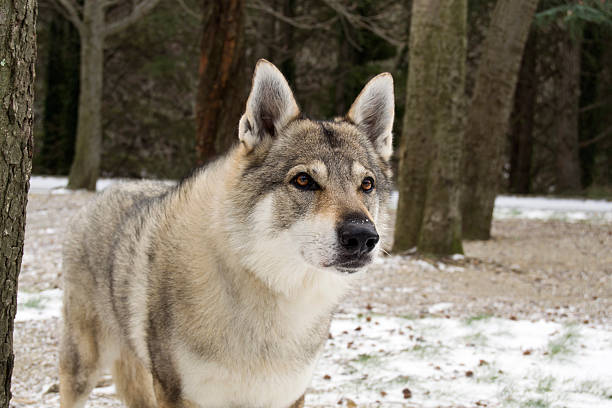Wolf-dog

Breed History:
Wolf Dogs are hybrids that result from crossing a domestic dog with a wild wolf. This interbreeding can occur naturally or be done intentionally by humans. Historically, such hybrids have existed for centuries, but intentional breeding for specific traits became more structured in the 20th century. The goal was often to combine the loyalty and trainability of domestic dogs with the physical strength and endurance of wolves.
Two notable recognised breeds emerged from such efforts: the Czechoslovakian Wolfdog, developed in the 1950s for military work by crossing German Shepherds with Carpathian wolves, and the Saarloos Wolfdog, created in the Netherlands by mixing a German Shepherd with a Eurasian wolf. While these two are standardised and recognised by kennel clubs, many other wolf-dog hybrids exist but are not officially recognised due to their unpredictable traits and complex ownership regulations.
|
Gender |
Height |
Weight |
|
Male |
65–80 cm |
30–50 kg |
|
Female |
60–75 cm |
25–45 kg |
Size – Large
Life Expectancy: 12–16 years

Breed Appearance:
Wolf-dogs closely resemble their wild ancestors in appearance, often featuring a lean, muscular build, bushy tail, amber or yellow eyes, and erect ears. Their coat is thick and double-layered, with colouration ranging from grey and sable to cream and black, depending on ancestry.
The structure varies with lineage: some look more like wolves, while others show clear dog-like traits. Their overall look is striking and wild, and their gait is fluid, with long strides and high endurance. Many wolf-dog hybrids have a high tail carriage and a noticeably strong jawline, contributing to their majestic but primal aura.
Breed Type – Companion/Working:
Wolf Dogs are complex animals that do not fit neatly into traditional pet categories. They are not typical companion animals and are best suited for experienced handlers. These hybrids have strong pack instincts, high energy levels, and a desire for hierarchy and structure, which can challenge even seasoned dog owners.
Wolf-dogs can form deep bonds with their owners but are often wary of strangers and may show territorial behaviours. Their temperament is shaped by genetics, socialisation, and training, making early intervention crucial. Due to their high prey drive, they are generally not recommended for households with small animals or young children.

Training:
Training a wolf-dog is a long-term commitment that requires patience, consistency, and a deep understanding of canine behaviour. These hybrids are intelligent but often stubborn and independent, especially those with a higher percentage of wolf ancestry.
Positive reinforcement is essential, but traditional obedience training may not always yield predictable results. Wolf Dogs often challenge commands and exhibit problem-solving skills that can sometimes work against their training. Socialisation from a very early age is non-negotiable to manage potential aggression or fear-based behaviours. They thrive with handlers who provide firm boundaries without using force or harsh correction.
Health & Care:
Wolf Dogs are generally hardy animals with fewer genetic health problems due to their diverse ancestry. However, they may be prone to conditions like hip dysplasia, digestive sensitivity, and parasitic infections, especially if not cared for properly.
Because of their thick coats, they are better suited for cooler climates. Diet is also an important consideration, as some Wolf Dogs thrive on raw or high-protein diets rather than commercial kibble. Regular vet visits can be complicated due to legal restrictions in some areas, so it's important to ensure your veterinarian is comfortable working with hybrids.

Living Conditions:
Wolf Dogs are not suited for typical urban or apartment living. They require spacious, secure enclosures with high, reinforced fencing—ideally with a dig-proof base and a covered top. These animals need constant mental stimulation, companionship, and physical exercise to prevent behavioural issues like digging, howling, or escape attempts.
They do best in rural or semi-rural environments with access to nature and freedom to roam in a controlled setting. Wolf Dogs also require more attention than average dogs and do poorly when left alone for extended periods.
Exercise:
Wolf Dogs are highly active and require significant daily exercise to remain balanced and healthy. Long walks, hikes, and off-leash exploration (in secure, fenced areas) are vital to their well-being. Mental stimulation through training, puzzles, and interaction is equally important to prevent boredom and frustration.
Without adequate outlets for energy, Wolf Dogs can become destructive or even dangerous. Their endurance and stamina often surpass that of domestic dogs, so routine activity must be intense and engaging. They are not well-suited to casual pet owners or sedentary lifestyles.
Grooming:
Wolf Dogs have thick, double coats that shed heavily, especially during seasonal changes. Weekly brushing is recommended year-round, with more frequent grooming during spring and fall shedding periods to manage loose fur and maintain coat health.
Bathing should be minimal—only when necessary—to preserve the natural oils in the coat. Ear cleaning, nail trimming, and dental care are also essential but may require acclimation due to the breed’s independent temperament. Patience and early desensitisation are key to successful grooming routines.

Advantages:
-
Unique and majestic appearance, closely resembling a wild wolf
-
Deep loyalty and bond with their trusted owner or family
-
Highly intelligent and problem-solving abilities
-
Great stamina and endurance, ideal for outdoor enthusiasts
-
Generally healthy and long-lived when properly cared for
-
Rare and striking breed that appeals to experienced handlers
Disadvantages:
-
Not suitable for novice owners; requires deep canine behavioural knowledge
-
Difficult to train and may resist commands or routine obedience
-
High prey drive and potential aggression toward small pets or strangers
-
Requires a large, secure enclosure to prevent escapes
-
May be subject to legal restrictions or bans in certain regions
-
Poor candidates for urban environments or apartment living
-
Prone to separation anxiety and destructive behaviour when understimulated

